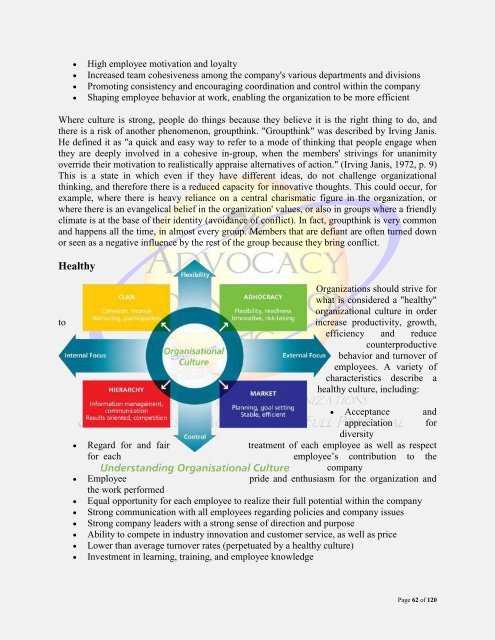Organizational Development - Vol. V, Part II
Organizational Development - Vol. V, Part II
Organizational Development - Vol. V, Part II
Create successful ePaper yourself
Turn your PDF publications into a flip-book with our unique Google optimized e-Paper software.
High employee motivation and loyalty<br />
Increased team cohesiveness among the company's various departments and divisions<br />
Promoting consistency and encouraging coordination and control within the company<br />
Shaping employee behavior at work, enabling the organization to be more efficient<br />
Where culture is strong, people do things because they believe it is the right thing to do, and<br />
there is a risk of another phenomenon, groupthink. "Groupthink" was described by Irving Janis.<br />
He defined it as "a quick and easy way to refer to a mode of thinking that people engage when<br />
they are deeply involved in a cohesive in-group, when the members' strivings for unanimity<br />
override their motivation to realistically appraise alternatives of action." (Irving Janis, 1972, p. 9)<br />
This is a state in which even if they have different ideas, do not challenge organizational<br />
thinking, and therefore there is a reduced capacity for innovative thoughts. This could occur, for<br />
example, where there is heavy reliance on a central charismatic figure in the organization, or<br />
where there is an evangelical belief in the organization' values, or also in groups where a friendly<br />
climate is at the base of their identity (avoidance of conflict). In fact, groupthink is very common<br />
and happens all the time, in almost every group. Members that are defiant are often turned down<br />
or seen as a negative influence by the rest of the group because they bring conflict.<br />
Healthy<br />
to<br />
Organizations should strive for<br />
what is considered a "healthy"<br />
organizational culture in order<br />
increase productivity, growth,<br />
efficiency and reduce<br />
counterproductive<br />
behavior and turnover of<br />
employees. A variety of<br />
characteristics describe a<br />
healthy culture, including:<br />
Acceptance and<br />
appreciation for<br />
diversity<br />
Regard for and fair treatment of each employee as well as respect<br />
for each employee‘s contribution to the<br />
company<br />
Employee pride and enthusiasm for the organization and<br />
the work performed<br />
Equal opportunity for each employee to realize their full potential within the company<br />
Strong communication with all employees regarding policies and company issues<br />
Strong company leaders with a strong sense of direction and purpose<br />
Ability to compete in industry innovation and customer service, as well as price<br />
Lower than average turnover rates (perpetuated by a healthy culture)<br />
Investment in learning, training, and employee knowledge<br />
Page 62 of 120

















